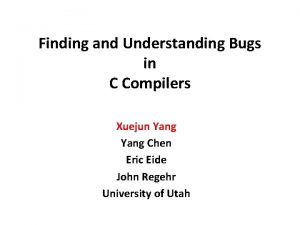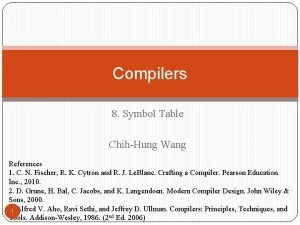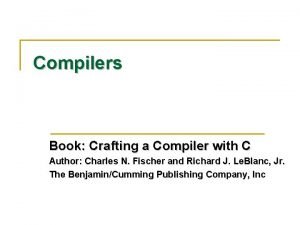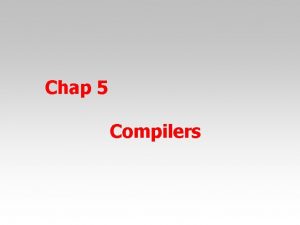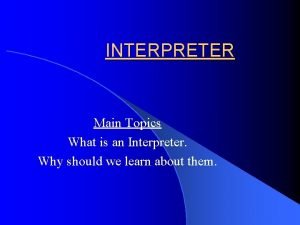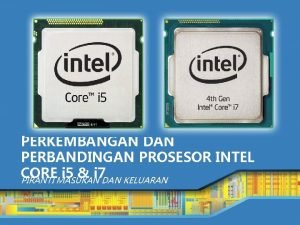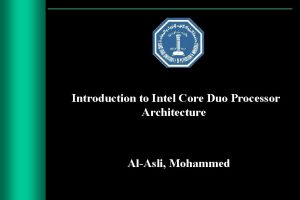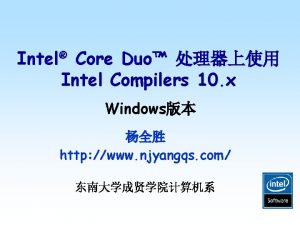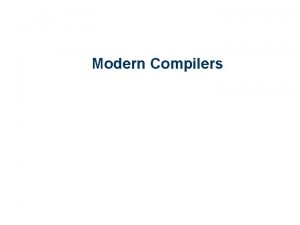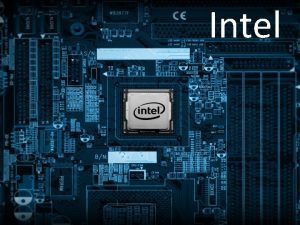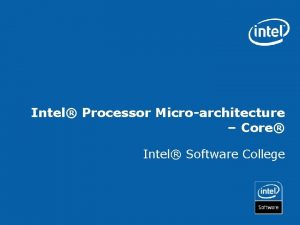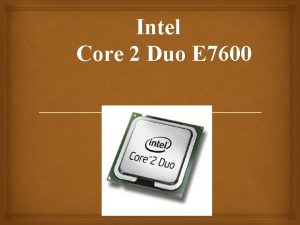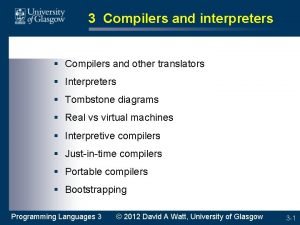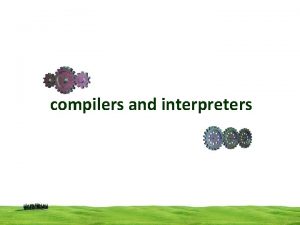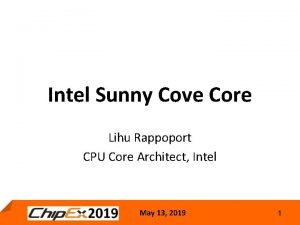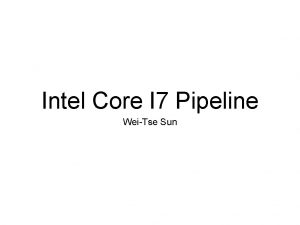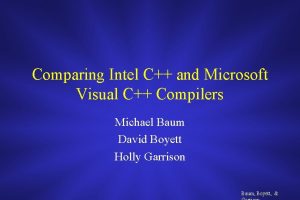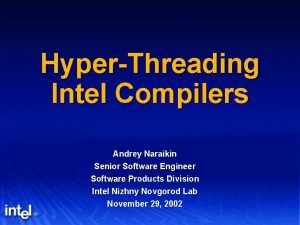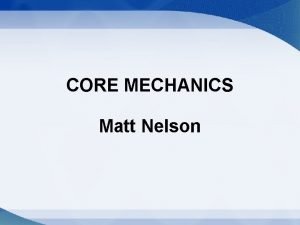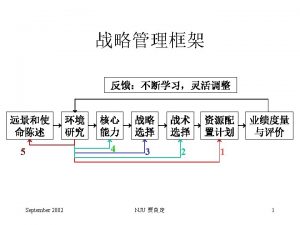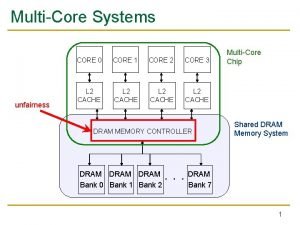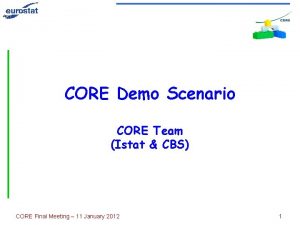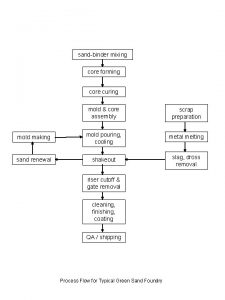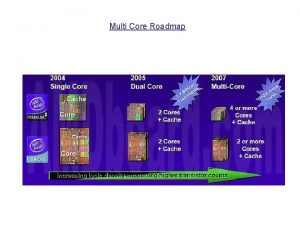Intel Compilers 9 x on the Intel Core











![Multi-pass Optimization PGO: Three-Step Process Step 1 Instrumented Compilation Instrumented executable (Mac*/Linux*) icc -prof_gen[x] Multi-pass Optimization PGO: Three-Step Process Step 1 Instrumented Compilation Instrumented executable (Mac*/Linux*) icc -prof_gen[x]](https://slidetodoc.com/presentation_image/5417c11ff62ec16358d2ce190e469709/image-12.jpg)








![Using SSE 3 - Your Task: Convert This… for (i=0; i<=MAX; i++) c[i]=a[i]+b[i]; A[1] Using SSE 3 - Your Task: Convert This… for (i=0; i<=MAX; i++) c[i]=a[i]+b[i]; A[1]](https://slidetodoc.com/presentation_image/5417c11ff62ec16358d2ce190e469709/image-21.jpg)
![… Into This … for (i=0; i<=MAX; i++) c[i]=a[i]+b[i]; A[3] + A[2] + A[1] … Into This … for (i=0; i<=MAX; i++) c[i]=a[i]+b[i]; A[3] + A[2] + A[1]](https://slidetodoc.com/presentation_image/5417c11ff62ec16358d2ce190e469709/image-22.jpg)

![Compiler Based Vectorization Automatic Processor Dispatch – ax[? ] Single executable • Optimized for Compiler Based Vectorization Automatic Processor Dispatch – ax[? ] Single executable • Optimized for](https://slidetodoc.com/presentation_image/5417c11ff62ec16358d2ce190e469709/image-24.jpg)





![“Nonunit stride used” Memory for (I=0; I<=MAX; I++) for (J=0; J<=MAX; J++) { c[I][J]+=1; “Nonunit stride used” Memory for (I=0; I<=MAX; I++) for (J=0; J<=MAX; J++) { c[I][J]+=1;](https://slidetodoc.com/presentation_image/5417c11ff62ec16358d2ce190e469709/image-30.jpg)


![“Contains unvectorizable statement” for (i=1; i<nx; i++) { B[i] = func(A[i]); } A[3] func “Contains unvectorizable statement” for (i=1; i<nx; i++) { B[i] = func(A[i]); } A[3] func](https://slidetodoc.com/presentation_image/5417c11ff62ec16358d2ce190e469709/image-33.jpg)








- Slides: 41

Intel Compilers 9. x on the Intel® Core Duo™ Processor Windows version Intel Software College

Objectives At the successful completion of this module, you will be able to: • Use key compiler optimization switches • Optimize software for the Architecture • Enhance performance with vectorization and other techniques Intel Compilers 9. x on the Intel® Core Duo™ Processor Windows version 2 Copyright © 2006, Intel Corporation. All rights reserved. Intel and the Intel logo are trademarks or registered trademarks of Intel Corporation or its subsidiaries in the United States or other countries. *Other brands and names are the property of their respective owners.

Agenda Introduction Compiler Switches Dual Core Vectorization Intel Compilers 9. x on the Intel® Core Duo™ Processor Windows version 3 Copyright © 2006, Intel Corporation. All rights reserved. Intel and the Intel logo are trademarks or registered trademarks of Intel Corporation or its subsidiaries in the United States or other countries. *Other brands and names are the property of their respective owners.

Key to optimizing: Intel® Core™ Duo Exploiting Architectural Power requires Sophisticated Compilers Optimal use of • Registers & functional units • Dual-Core/Multi-processor • SSE instructions • Cache architecture Intel Compilers 9. x on the Intel® Core Duo™ Processor Windows version 4 Copyright © 2006, Intel Corporation. All rights reserved. Intel and the Intel logo are trademarks or registered trademarks of Intel Corporation or its subsidiaries in the United States or other countries. *Other brands and names are the property of their respective owners.

C++ Compatibility with Microsoft Source & binary compatible with VC 2003 with /Qvc 71, Source & binary compatible with w/ VC 2005 under /Qvc 8. Microsoft* & Intel Open. MP binaries are not compatible. • Use the one compiler for all modules compiled with Open. MP For more information, refer to the User’s Guide Intel Compilers 9. x on the Intel® Core Duo™ Processor Windows version 5 Copyright © 2006, Intel Corporation. All rights reserved. Intel and the Intel logo are trademarks or registered trademarks of Intel Corporation or its subsidiaries in the United States or other countries. *Other brands and names are the property of their respective owners.

Use Intel Compiler in Microsoft IDE C++ Intel Compilers 9. x on the Intel® Core Duo™ Processor Windows version 6 Copyright © 2006, Intel Corporation. All rights reserved. Intel and the Intel logo are trademarks or registered trademarks of Intel Corporation or its subsidiaries in the United States or other countries. *Other brands and names are the property of their respective owners.

Agenda Introduction Compiler Switches • Intel® C++ compiler Dual Core Vectorization Intel Compilers 9. x on the Intel® Core Duo™ Processor Windows version 7 Copyright © 2006, Intel Corporation. All rights reserved. Intel and the Intel logo are trademarks or registered trademarks of Intel Corporation or its subsidiaries in the United States or other countries. *Other brands and names are the property of their respective owners.

General Optimizations Windows* Linux* Mac* /Od -O 0 Disables optimizations /Zi -g -g Creates symbols /O 1 -O 1 Optimize for Binary Size: Server Code /O 2 -O 2 Optimizes for speed (default) /O 3 -O 3 Optimize for Data Cache: Loopy Floating Point Code Intel Compilers 9. x on the Intel® Core Duo™ Processor Windows version 8 Copyright © 2006, Intel Corporation. All rights reserved. Intel and the Intel logo are trademarks or registered trademarks of Intel Corporation or its subsidiaries in the United States or other countries. *Other brands and names are the property of their respective owners.

Multi-pass Optimization Interprocedural Optimizations (IPO) ip: Enables interprocedural optimizations for single file compilation ipo: Enables interprocedural optimizations across files Windows* Linux* Mac* /Qip -ip /Qipo -ipo Can inline functions in separate files Enhances optimization when used in combination with other compiler features Intel Compilers 9. x on the Intel® Core Duo™ Processor Windows version 9 Copyright © 2006, Intel Corporation. All rights reserved. Intel and the Intel logo are trademarks or registered trademarks of Intel Corporation or its subsidiaries in the United States or other countries. *Other brands and names are the property of their respective owners.

Multi-pass Optimization - IPO Usage: Two-Step Process Compiling Pass 1 Windows* icl -c /Qipo main. c func 1. c func 2. c Linux* icc -c -ipo main. c func 1. c func 2. c Mac* icc -c -ipo main. c func 1. c func 2. c virtual. o Pass 2 executable Linking Windows* icl /Qipo main. o func 1. o func 2. o Linux* icc -ipo main. o func 1. o func 2. o Mac* icc -ipo main. o func 1. o func 2. o Intel Compilers 9. x on the Intel® Core Duo™ Processor Windows version 10 Copyright © 2006, Intel Corporation. All rights reserved. Intel and the Intel logo are trademarks or registered trademarks of Intel Corporation or its subsidiaries in the United States or other countries. *Other brands and names are the property of their respective owners.

Profile Guided Optimizations (PGO) Use execution-time feedback to guide many other compiler optimizations Helps I-cache, paging, branch-prediction Enabled optimizations: • Basic block ordering • Better register allocation • Better decision of functions to inline • Function ordering • Switch-statement optimization • Better vectorization decisions Intel Compilers 9. x on the Intel® Core Duo™ Processor Windows version 11 Copyright © 2006, Intel Corporation. All rights reserved. Intel and the Intel logo are trademarks or registered trademarks of Intel Corporation or its subsidiaries in the United States or other countries. *Other brands and names are the property of their respective owners.
![Multipass Optimization PGO ThreeStep Process Step 1 Instrumented Compilation Instrumented executable MacLinux icc profgenx Multi-pass Optimization PGO: Three-Step Process Step 1 Instrumented Compilation Instrumented executable (Mac*/Linux*) icc -prof_gen[x]](https://slidetodoc.com/presentation_image/5417c11ff62ec16358d2ce190e469709/image-12.jpg)
Multi-pass Optimization PGO: Three-Step Process Step 1 Instrumented Compilation Instrumented executable (Mac*/Linux*) icc -prof_gen[x] prog. c (Windows*) icl -Qprof_gen[x] prog. c Step 2 Instrumented Execution Run program on a typical dataset Step 3 Feedback Compilation (Mac/Linux) icc -prof_use prog. c (Windows) icl -Qprof_use prog. c DYN file containing dynamic info: . dyn Merged DYN summary file: . dpi Delete old dyn files if you do not want the info included Intel Compilers 9. x on the Intel® Core Duo™ Processor Windows version 12 Copyright © 2006, Intel Corporation. All rights reserved. Intel and the Intel logo are trademarks or registered trademarks of Intel Corporation or its subsidiaries in the United States or other countries. *Other brands and names are the property of their respective owners.

Agenda Introduction Compiler Switches Dual Core • • • Auto Parallelization Open. MP Threading Diagnostics Vectorization Intel Compilers 9. x on the Intel® Core Duo™ Processor Windows version 13 Copyright © 2006, Intel Corporation. All rights reserved. Intel and the Intel logo are trademarks or registered trademarks of Intel Corporation or its subsidiaries in the United States or other countries. *Other brands and names are the property of their respective owners.

Auto-parallelization: Automatic threading of loops without having to manually insert Open. MP* directives. Windows* Linux* Mac* /Qparallel -parallel /Qpar_report[n] -par_report[n] • Compiler can identify “easy” candidates for parallelization, but large applications are difficult to analyze. Intel Compilers 9. x on the Intel® Core Duo™ Processor Windows version 14 Copyright © 2006, Intel Corporation. All rights reserved. Intel and the Intel logo are trademarks or registered trademarks of Intel Corporation or its subsidiaries in the United States or other countries. *Other brands and names are the property of their respective owners.

Open. MP* Threading Technology Pragma based approach to parallelism Usage: Open. MP switches: -openmp : /Qopenmp Open. MP reports: -openmp-report : /Qopenmp-report #pragma omp parallel for (i=0; i<MAX; i++) A[i]= c*A[i] + B[i]; Intel Compilers 9. x on the Intel® Core Duo™ Processor Windows version 15 Copyright © 2006, Intel Corporation. All rights reserved. Intel and the Intel logo are trademarks or registered trademarks of Intel Corporation or its subsidiaries in the United States or other countries. *Other brands and names are the property of their respective owners.

Open. MP: Workqueueing Extension Example Intel Compiler’s Workqueuing extension • Create Queue of tasks…Works on… • • Recursive functions Linked lists, etc. #pragma intel omp parallel taskq shared(p) { while (p != NULL) { #pragma intel omp task captureprivate(p) do_work 1(p); p = p->next; } } Intel Compilers 9. x on the Intel® Core Duo™ Processor Windows version 16 Copyright © 2006, Intel Corporation. All rights reserved. Intel and the Intel logo are trademarks or registered trademarks of Intel Corporation or its subsidiaries in the United States or other countries. *Other brands and names are the property of their respective owners.

Parallel Diagnostics Source Instrumentation for Intel Thread Checker • Allows thread checker to diagnose threading correctness bugs • To use tcheck/Qtcheck you must have Intel Thread Checker installed • • See thread checker documentation http: //www. intel. com/support/perfor mancetools/sb/CS-009681. htm Windows* Linux* Mac* /Qtcheck No support -tcheck Intel Compilers 9. x on the Intel® Core Duo™ Processor Windows version 17 Copyright © 2006, Intel Corporation. All rights reserved. Intel and the Intel logo are trademarks or registered trademarks of Intel Corporation or its subsidiaries in the United States or other countries. *Other brands and names are the property of their respective owners.

Agenda Introduction Compiler Switches Dual Core Vectorization • • • SSE & Vectorization Reports Explanations of a few specific vectorization inhibitors Intel Compilers 9. x on the Intel® Core Duo™ Processor Windows version 18 Copyright © 2006, Intel Corporation. All rights reserved. Intel and the Intel logo are trademarks or registered trademarks of Intel Corporation or its subsidiaries in the United States or other countries. *Other brands and names are the property of their respective owners.

SIMD – SSE, SSE 2, SSE 3 Support 2 x doubles 4 x floats 1 x dqword SSE 2 SSE 3 16 x bytes SSE 8 x words MMX* 4 x dwords 2 x qwords * MMX actually used the x 87 Floating Point Registers - SSE, SSE 2, and SSE 3 use the new SSE registers Intel Compilers 9. x on the Intel® Core Duo™ Processor Windows version 19 Copyright © 2006, Intel Corporation. All rights reserved. Intel and the Intel logo are trademarks or registered trademarks of Intel Corporation or its subsidiaries in the United States or other countries. *Other brands and names are the property of their respective owners.

SSE 3 Instructions FISTTP FP to integer conversions ADDSUBPD, ADDSUBPS, Complex arithmetic MOVDDUP, MOVSHDUP, MOVSLDUP Video encoding SIMD FP using AOS format* LDDQU HADDPD, HSUBPD Thread Synchronization HADDPS, HSUBPS MONITOR, MWAIT * Also benefits Complex and Vectorization Intel Compilers 9. x on the Intel® Core Duo™ Processor Windows version 20 Copyright © 2006, Intel Corporation. All rights reserved. Intel and the Intel logo are trademarks or registered trademarks of Intel Corporation or its subsidiaries in the United States or other countries. *Other brands and names are the property of their respective owners.
![Using SSE 3 Your Task Convert This for i0 iMAX i ciaibi A1 Using SSE 3 - Your Task: Convert This… for (i=0; i<=MAX; i++) c[i]=a[i]+b[i]; A[1]](https://slidetodoc.com/presentation_image/5417c11ff62ec16358d2ce190e469709/image-21.jpg)
Using SSE 3 - Your Task: Convert This… for (i=0; i<=MAX; i++) c[i]=a[i]+b[i]; A[1] A[0] + not used + B[0] B[1] not used C[0] C[1] not used + 128 -bit Registers not used Intel Compilers 9. x on the Intel® Core Duo™ Processor Windows version 21 Copyright © 2006, Intel Corporation. All rights reserved. Intel and the Intel logo are trademarks or registered trademarks of Intel Corporation or its subsidiaries in the United States or other countries. *Other brands and names are the property of their respective owners.
![Into This for i0 iMAX i ciaibi A3 A2 A1 … Into This … for (i=0; i<=MAX; i++) c[i]=a[i]+b[i]; A[3] + A[2] + A[1]](https://slidetodoc.com/presentation_image/5417c11ff62ec16358d2ce190e469709/image-22.jpg)
… Into This … for (i=0; i<=MAX; i++) c[i]=a[i]+b[i]; A[3] + A[2] + A[1] B[3] B[2] B[1] C[3] C[2] C[1] A[0] + + 128 -bit Registers B[0] C[0] Intel Compilers 9. x on the Intel® Core Duo™ Processor Windows version 22 Copyright © 2006, Intel Corporation. All rights reserved. Intel and the Intel logo are trademarks or registered trademarks of Intel Corporation or its subsidiaries in the United States or other countries. *Other brands and names are the property of their respective owners.

Compiler Based Vectorization Processor Specific Description Use Windows* Linux* Mac* Generate instructions and optimize for Intel® Pentium® 4 compatible processors including MMX, SSE and SSE 2. W /Qx. W -x. W Does not apply Generate instructions and optimize for Intel® processors with SSE 3 capability including Core Duo. These processors support SSE 3 as well as MMX, SSE and SSE 2. P /Qx. P /Qax. P -x. P, -ax. P Vectorization occurs by default Intel Compilers 9. x on the Intel® Core Duo™ Processor Windows version 23 Copyright © 2006, Intel Corporation. All rights reserved. Intel and the Intel logo are trademarks or registered trademarks of Intel Corporation or its subsidiaries in the United States or other countries. *Other brands and names are the property of their respective owners.
![Compiler Based Vectorization Automatic Processor Dispatch ax Single executable Optimized for Compiler Based Vectorization Automatic Processor Dispatch – ax[? ] Single executable • Optimized for](https://slidetodoc.com/presentation_image/5417c11ff62ec16358d2ce190e469709/image-24.jpg)
Compiler Based Vectorization Automatic Processor Dispatch – ax[? ] Single executable • Optimized for Intel® Core Duo processors and generic code that runs on all IA 32 processors. For each target processor it uses: • Processor-specific instructions • Vectorization Low overhead • Some increase in code size Intel Compilers 9. x on the Intel® Core Duo™ Processor Windows version 24 Copyright © 2006, Intel Corporation. All rights reserved. Intel and the Intel logo are trademarks or registered trademarks of Intel Corporation or its subsidiaries in the United States or other countries. *Other brands and names are the property of their respective owners.

Why Loops Don’t Vectorize Independence • Loop Iterations generally must be independent Some relevant qualifiers: • Some dependent loops can be vectorized. • Most function calls cannot be vectorized. • Some conditional branches prevent vectorization. • Loops must be countable. • Outer loop of nest cannot be vectorized. • Mixed data types cannot be vectorized. Intel Compilers 9. x on the Intel® Core Duo™ Processor Windows version 25 Copyright © 2006, Intel Corporation. All rights reserved. Intel and the Intel logo are trademarks or registered trademarks of Intel Corporation or its subsidiaries in the United States or other countries. *Other brands and names are the property of their respective owners.

Why Didn’t My Loop Vectorize? Windows* Linux* Macintosh* -Qvec_reportn -vec_reportn Set diagnostic level dumped to stdout n=0: No diagnostic information n=1: (Default) Loops successfully vectorized n=2: Loops not vectorized – and the reason why not n=3: Adds dependency Information n=4: Reports only non-vectorized loops n=5: Reports only non-vectorized loops and adds dependency info Intel Compilers 9. x on the Intel® Core Duo™ Processor Windows version 26 Copyright © 2006, Intel Corporation. All rights reserved. Intel and the Intel logo are trademarks or registered trademarks of Intel Corporation or its subsidiaries in the United States or other countries. *Other brands and names are the property of their respective owners.

Why Loops Don’t Vectorize • “Existence of vector dependence” • “Nonunit stride used” • “Mixed Data Types” • “Unsupported Loop Structure” • “Contains unvectorizable statement at line XX” • There are more reasons loops don’t vectorize but we will disucss the reasons above Intel Compilers 9. x on the Intel® Core Duo™ Processor Windows version 27 Copyright © 2006, Intel Corporation. All rights reserved. Intel and the Intel logo are trademarks or registered trademarks of Intel Corporation or its subsidiaries in the United States or other countries. *Other brands and names are the property of their respective owners.

“Existence of Vector Dependency” Usually, indicates a real dependency between iterations of the loop, as shown here: for (i = 0; i < 100; i++) x[i] = A * x[i + 1]; Intel Compilers 9. x on the Intel® Core Duo™ Processor Windows version 28 Copyright © 2006, Intel Corporation. All rights reserved. Intel and the Intel logo are trademarks or registered trademarks of Intel Corporation or its subsidiaries in the United States or other countries. *Other brands and names are the property of their respective owners.

Defining Loop Independence Iteration Y of a loop is independent of when (or whether) iteration X occurs. int a[MAX], b[MAX]; for (j=0; j<MAX; j++) { a[j] = b[j]; } Intel Compilers 9. x on the Intel® Core Duo™ Processor Windows version 29 Copyright © 2006, Intel Corporation. All rights reserved. Intel and the Intel logo are trademarks or registered trademarks of Intel Corporation or its subsidiaries in the United States or other countries. *Other brands and names are the property of their respective owners.
![Nonunit stride used Memory for I0 IMAX I for J0 JMAX J cIJ1 “Nonunit stride used” Memory for (I=0; I<=MAX; I++) for (J=0; J<=MAX; J++) { c[I][J]+=1;](https://slidetodoc.com/presentation_image/5417c11ff62ec16358d2ce190e469709/image-30.jpg)
“Nonunit stride used” Memory for (I=0; I<=MAX; I++) for (J=0; J<=MAX; J++) { c[I][J]+=1; // Unit Stride c[J][I]+=1; // Non-Unit A[J*J]+=1; // Non-unit A[B[J]]+=1; // Non-Unit if (A[MAX-J])=1 last 1=J; }// Non-Unit End Result: Loading Vector may take more cycles than executing operation sequentially. Intel Compilers 9. x on the Intel® Core Duo™ Processor Windows version 30 Copyright © 2006, Intel Corporation. All rights reserved. Intel and the Intel logo are trademarks or registered trademarks of Intel Corporation or its subsidiaries in the United States or other countries. *Other brands and names are the property of their respective owners.

“Mixed Data Types” An example: int howmany_close(double *x, double *y) { int withinborder=0; double dist; for(int i=0; i<MAX; i++) { dist=sqrtf(x[i]*x[i] + y[i]*y[i]); if (dist<5) withinborder++; } } Mixed data types are possible – but complicate things • i. e. : 2 doubles vs 4 ints per SIMD register Some operations with specific data types won’t work Intel Compilers 9. x on the Intel® Core Duo™ Processor Windows version 31 Copyright © 2006, Intel Corporation. All rights reserved. Intel and the Intel logo are trademarks or registered trademarks of Intel Corporation or its subsidiaries in the United States or other countries. *Other brands and names are the property of their respective owners.

“Unsupported Loop Structure” Example: struct _xx { int data; int bound; } ; doit 1(int *a, struct _xx *x) { for (int i=0; i<x->bound; i++) a[i] = 0; An unsupported loop structure means the loop is not countable, or the compiler for whatever reason can’t construct a run-time expression for the trip count. Intel Compilers 9. x on the Intel® Core Duo™ Processor Windows version 32 Copyright © 2006, Intel Corporation. All rights reserved. Intel and the Intel logo are trademarks or registered trademarks of Intel Corporation or its subsidiaries in the United States or other countries. *Other brands and names are the property of their respective owners.
![Contains unvectorizable statement for i1 inx i Bi funcAi A3 func “Contains unvectorizable statement” for (i=1; i<nx; i++) { B[i] = func(A[i]); } A[3] func](https://slidetodoc.com/presentation_image/5417c11ff62ec16358d2ce190e469709/image-33.jpg)
“Contains unvectorizable statement” for (i=1; i<nx; i++) { B[i] = func(A[i]); } A[3] func A[2] func A[1] func B[3] B[2] B[1] A[0] func 128 -bit Registers B[0] Intel Compilers 9. x on the Intel® Core Duo™ Processor Windows version 33 Copyright © 2006, Intel Corporation. All rights reserved. Intel and the Intel logo are trademarks or registered trademarks of Intel Corporation or its subsidiaries in the United States or other countries. *Other brands and names are the property of their respective owners.

Reference Web-based and classroom training • www. intel. com/software/college White papers and technical notes • www. intel. com/ids • www. intel. com/software/products Product support resources • www. intel. com/software/products/support Intel Compilers 9. x on the Intel® Core Duo™ Processor Windows version 34 Copyright © 2006, Intel Corporation. All rights reserved. Intel and the Intel logo are trademarks or registered trademarks of Intel Corporation or its subsidiaries in the United States or other countries. *Other brands and names are the property of their respective owners.

Intel Compilers 9. x on the Intel® Core Duo™ Processor Windows version 35 Copyright © 2006, Intel Corporation. All rights reserved. Intel and the Intel logo are trademarks or registered trademarks of Intel Corporation or its subsidiaries in the United States or other countries. *Other brands and names are the property of their respective owners.

Activity 1 - raytrace 2: Initial Compilation Set up environment and compile with both Microsoft* Visual C++. NET (MSVC*) and Intel® C++ Compiler (icl) Intel Compilers 9. x on the Intel® Core Duo™ Processor Windows version 36 Copyright © 2006, Intel Corporation. All rights reserved. Intel and the Intel logo are trademarks or registered trademarks of Intel Corporation or its subsidiaries in the United States or other countries. *Other brands and names are the property of their respective owners.

Activity 2 - raytrace 2: O 3 Compilation Use Intel compiler’s High Level Optimizer (-O 3) for loop centric codes Intel Compilers 9. x on the Intel® Core Duo™ Processor Windows version 37 Copyright © 2006, Intel Corporation. All rights reserved. Intel and the Intel logo are trademarks or registered trademarks of Intel Corporation or its subsidiaries in the United States or other countries. *Other brands and names are the property of their respective owners.

Activity 3 - raytrace 2: IPO Compilation Use Intel compiler’s Inter-procedural Optimization (-Qipo) Intel Compilers 9. x on the Intel® Core Duo™ Processor Windows version 38 Copyright © 2006, Intel Corporation. All rights reserved. Intel and the Intel logo are trademarks or registered trademarks of Intel Corporation or its subsidiaries in the United States or other countries. *Other brands and names are the property of their respective owners.

Activity 4 - raytrace 2: PGO Compilation Use Intel compiler’s Profile-guided Optimization Intel Compilers 9. x on the Intel® Core Duo™ Processor Windows version 39 Copyright © 2006, Intel Corporation. All rights reserved. Intel and the Intel logo are trademarks or registered trademarks of Intel Corporation or its subsidiaries in the United States or other countries. *Other brands and names are the property of their respective owners.

Activity 5 – raytrace 2: Vectorization Use Intel compiler’s Vectorization optimization (-Qx. P) Intel Compilers 9. x on the Intel® Core Duo™ Processor Windows version 40 Copyright © 2006, Intel Corporation. All rights reserved. Intel and the Intel logo are trademarks or registered trademarks of Intel Corporation or its subsidiaries in the United States or other countries. *Other brands and names are the property of their respective owners.

Activity 6 - raytrace 2: Putting it all together Use all previous optimizations in tandem (-O 3, -Qx. P, IPO and PGO) Intel Compilers 9. x on the Intel® Core Duo™ Processor Windows version 41 Copyright © 2006, Intel Corporation. All rights reserved. Intel and the Intel logo are trademarks or registered trademarks of Intel Corporation or its subsidiaries in the United States or other countries. *Other brands and names are the property of their respective owners.
 Elsa gunter uiuc
Elsa gunter uiuc Finding and understanding bugs in c compilers
Finding and understanding bugs in c compilers Compilers: principles, techniques, and tools
Compilers: principles, techniques, and tools C++ binarymove
C++ binarymove Compilers book
Compilers book Compilers and interpreters are themselves
Compilers and interpreters are themselves Cross compilers
Cross compilers Functions of compiler
Functions of compiler Cs 421 uiuc
Cs 421 uiuc Pros and cons of compilers and interpreters
Pros and cons of compilers and interpreters Front end in compiler design
Front end in compiler design 8088 microprocessor architecture
8088 microprocessor architecture Perkembangan intel
Perkembangan intel Intel core processor architecture
Intel core processor architecture Intel core competencies
Intel core competencies Mantle is made up of
Mantle is made up of Layers of earth from most dense to least dense
Layers of earth from most dense to least dense Core rigidity
Core rigidity The brittle, rocky outer layer of earth
The brittle, rocky outer layer of earth Thế nào là mạng điện lắp đặt kiểu nổi
Thế nào là mạng điện lắp đặt kiểu nổi Hình ảnh bộ gõ cơ thể búng tay
Hình ảnh bộ gõ cơ thể búng tay Khi nào hổ mẹ dạy hổ con săn mồi
Khi nào hổ mẹ dạy hổ con săn mồi Các loại đột biến cấu trúc nhiễm sắc thể
Các loại đột biến cấu trúc nhiễm sắc thể Thế nào là sự mỏi cơ
Thế nào là sự mỏi cơ độ dài liên kết
độ dài liên kết Chó sói
Chó sói Thiếu nhi thế giới liên hoan
Thiếu nhi thế giới liên hoan Phối cảnh
Phối cảnh điện thế nghỉ
điện thế nghỉ Một số thể thơ truyền thống
Một số thể thơ truyền thống Trời xanh đây là của chúng ta thể thơ
Trời xanh đây là của chúng ta thể thơ Thế nào là hệ số cao nhất
Thế nào là hệ số cao nhất Hệ hô hấp
Hệ hô hấp Bảng số nguyên tố lớn hơn 1000
Bảng số nguyên tố lớn hơn 1000 đặc điểm cơ thể của người tối cổ
đặc điểm cơ thể của người tối cổ Các châu lục và đại dương trên thế giới
Các châu lục và đại dương trên thế giới Thang điểm glasgow
Thang điểm glasgow ưu thế lai là gì
ưu thế lai là gì Tư thế ngồi viết
Tư thế ngồi viết Cái miệng nó xinh thế chỉ nói điều hay thôi
Cái miệng nó xinh thế chỉ nói điều hay thôi Mật thư tọa độ 5x5
Mật thư tọa độ 5x5

